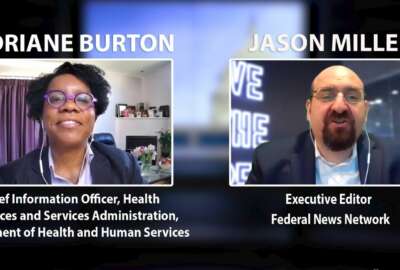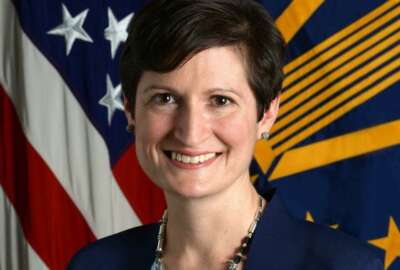
This head of an obscure multibillion-dollar agency, improves health care for millions of Americans
He runs a program most people never heard of, but it has got a $5 billion budget. He is the head of the Bureau of Primary Health Care, nested in the Health Reso...
He runs a program most people never heard of, but it has got a $5 billion budget. He is the head of the Bureau of Primary Health Care, nested in the Health Resources and Services Administration, itself a component of the Health and Human Services Department. The Federal Drive with Tom Temin talked with this senior executive and recent recipient of a Presidential Rank Award, James Macrae.
Interview transcript:
Tom Temin And congratulations on that award. Let’s talk about the Bureau of Primary Health Care. We can sort of imagine what it does, but why don’t you tell us what it does and what the scope of it is. It’s more extensive, I think, than people realize.
James Macrae Sure. Well, actually, we’re close to $6 billion now. So we’re an agency within the Health Resources and Services Administration, within the Department of Health and Human Services. And our mission is to provide resources to underserved communities to help support the provision of primary health care in this country.
Tom Temin Wow, and so there are a lot of places that lack primary health care, aren’t there?
James Macrae Yes. We actually, now have a total of about 1,400 community health centers across the country that operate close to 15,000 sites that provide affordable, accessible, basic health care services, including oral health, behavioral health, vision services to medically underserved populations. And today, we serve about 30 million people all across the country.
Tom Temin And is this delivered through private organizations, nonprofits? What are these 1,400 health centers like in that sense?
James Macrae These are all private, not for profit organizations. We have a few public entities, but 95% of these are community based organizations. And what’s unique about these organizations is that they are actually run by the patients themselves. So the governing boards of these organizations actually have to have at least 51% of the board be representative of the patients, actual patients of the center.
Tom Temin And how do you ensure, and we’ll get into the bigger picture here in a minute. But how do you ensure that if it is run by patients, that the doctors and the dentists and the psychologists that they hire are the best and most competent they can be?
James Macrae So as part of receiving the federal grants from us, there are some expectations, including related to the clinical quality of care that’s provided. All of these organizations must have a quality assurance program. The providers themselves must be licensed. They must meet both federal, state and local requirements. But the other piece of it is that, by having the organizations be run by patients at the center, it actually makes the care more responsive to what the actual needs are in the organization. And one of the things that happens quite a bit is the interaction between the provider staff and the governing boards, talking about what are the needs of the patients, how best to respond to those, and really keep a pulse of what’s happening in that community.
Tom Temin Interesting. So I imagine if they wanted then, the citizen run board or the patient run board could say, well, you know what? 9-5 doesn’t really work for medicine. What we need is something that opens at 3 p.m. and is there till midnight. And if the doctor’s willing to do that, personally, I don’t care where you live, that would be a much better situation.
James Macrae Well, and actually, to that end, most of our health centers do offer at least one evening a week and many work on the weekends and actually are responsive. In fact, the board itself is the organization that sets the hours of the organization. And they have communicated clearly to the staff and to the providers that we need to be open when people need access to care, and that includes evenings and weekends.
Tom Temin And if it costs, say, I’m just making this number up, $1 million a year to operate one of these centers, one of the 15,000. What portion of the operating expenses does HRSA grants cover?
James Macrae So on average, we provide about 20% of the revenues of these organizations. And what the grant is intended to do is to cover the costs that are not covered by other insurance. Significant number of our patients are Medicaid recipients. A significant number are Medicare. We also have some private insurance organizations. It’s of private insurance people, because we’re in underserved communities. But the remainder of that is covered by the grant itself. And with that grant there are expectations, in terms of the quality of care that’s provided financial accountability. We conduct site visits to make sure that the care is of the highest quality and produces the outcomes that we all want to see.
Tom Temin And tell us about yourself. What do you bring to this? Are you a physician by training, a federal program manager or a grant person? Who are you?
James Macrae Well, I am not a physician, but I have been in the federal government for now, almost 33 years. I’ve actually served as the associate administrator for the Bureau Primary Health Care for a little over 15 years. I worked in the program initially, as a young sort of person out of college and really grew up with it. And I’ve had the real opportunity to be able to lead this organization for a number of years, and we have seen some significant growth in the program over time.
Tom Temin And we’re speaking with Jim Macrae. He is head of the Bureau of Primary Health Care, part of the Health Resources and Services Administration, also a recipient of the Presidential Rank award. And let me ask you about that. Often we find that there’s a specific thing that someone did that garnered this award. What would it have been in your case? Because the White House doesn’t put out that information.
James Macrae Well, I think part of this award is definitely for the longevity and having worked across multiple different administrations. And I think the thing that, hopefully people have seen from my leadership, but most importantly from the program and these community based organizations, is that investments are made in these organizations. We do produce results. And so I’ve had the opportunity to work initially under the Bush administration, they had a big initiative to actually double the number of health center sites in the country. We were able to successfully do that. Under the Obama administration, we actually supported big efforts around the Recovery Act, both making sure that people had health care, but also promoting economic development by establishing new health center sites and facilities. We, of course, have supported the Affordable Care Act, during the Obama administration, to make sure that even if people have health insurance, to make sure, especially in rural and frontier and inner cities, that people had access to care and they could get it and it was affordable and accessible. During the Trump administration, we really worked on expanding the capacity of health centers to respond to the opioid crisis, expanding the capacity of our health centers to provide medication assisted treatment. And then most recently in the Biden administration, we’ve been instrumental in responding to COVID, and especially making sure that those communities that have been disproportionately impacted by COVID had access to vaccines, test masks and therapeutics. And so really, I’ve had the opportunity, over the last four administrations, to work very closely with each of them to hopefully deliver results that make a huge impact for medically underserved communities across the country.
Tom Temin And you’ve outlined how the organizations have had to bend and twist and accommodate different health phases, different crises that come along in public health. What about ensuring that the practitioners are up to date with the latest medical practices? Like, there’s so many little things, I’ve noticed the way dentists give lidocaine, they use different techniques than they used to, just plunge the needle in there and push. I mean, little things and big things. And how do you ensure that people that are accessing these facilities get the same things people in Upper Manhattan also get?
James Macrae Sure. So a couple of things, Tom, that we’ve done. One, is that we have worked with an outside organization to have our health centers recognized as patient centered medical homes, which is a national quality benchmark. When we started this initiative in 2010, we had less than 1% of our health centers recognized. Now we’re close to 80% of our organizations have received this outside quality recognition. In addition, we have promoted and supported the training of new residents and students out of medical schools to have the experience working in a community based setting. As you know, most of medical education today is done in hospitals. But one of the things that we see as critically important is getting residents in medical schools, exposure to community based settings, to serving underserved populations and practicing in primary care settings. And as we’ve done that, it not only hopefully increases the capacity of those students to provide primary health care, but it also helps keep our practitioners on the cutting edge of the services that are needed. Really, that interaction between students and our providers is critical. And the good news is what we see is if students do have that exposure, they’re more likely to go into primary health care, which is a huge need in this country. But they also are more likely to practice in underserved communities.
Tom Temin Right. So part of the job then is almost selling them on the idea that you might be in rural Pennsylvania, rural South Dakota, rural somewhere. And it’s not going to be like practicing on the Upper East Side of Manhattan, but it can be fulfilling.
James Macrae Absolutely, completely fulfilling. And you’ve probably seen the movies like Doc Hollywood, a lot of different activities about what it means, in terms of people’s personal lives. It’s very fulfilling. I will say, that the staff that work here in the Bureau Primary Health Care, and of course, the staff out in our community health centers are so mission driven and committed to making sure that people, again, have access to affordable, accessible, high quality primary health care. And what you can see is that it makes a huge difference in their lives. I mean, we’re delivering hundreds of thousands of babies every year in communities all across the country. We are helping people control their hypertension, their diabetes, and we’re also preventing disease. And that opportunity to see real world what happens and the impact that it’s making is really rewarding.
Tom Temin And what has kept you in federal senior service all this time? You could probably triple your salary at one of these health delivering organizations themselves.
James Macrae Well, it’s a great question. I would say it’s the mission and the people. One of the things that drew me to the Community Health Center program was to see that impact every day. And what has kept me here, is that working at the federal level, you can either make it easier or sometimes harder on individuals trying to deliver federal services. And my commitment and my staff’s commitment is always let’s try to make it easier to deliver that care. And we’ve seen that it happens, and as you were talking a little bit earlier, we really work closely with our partners to be flexible in terms of how we approach different issues. And we’re committed to working towards the same goals of providing that high quality health care, eliminating health disparities in this country. And the way I describe it is to be tight on the what. What is it that we’re trying to achieve? And looser on the how, in terms of how we do it together.
Copyright © 2024 Federal News Network. All rights reserved. This website is not intended for users located within the European Economic Area.
Tom Temin is host of the Federal Drive and has been providing insight on federal technology and management issues for more than 30 years.
Follow @tteminWFED





